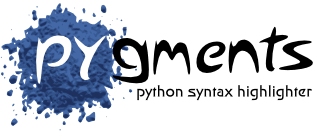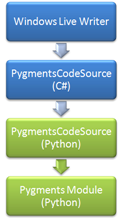Arguably, the biggest feature of C# 4.0 is the new dynamic type. And it’ll be great…when it ships. In the meantime, some of us what to build hybrid C# and IronPython applications today, such as my Pygments for Windows Live Writer plugin.

Pygments is a syntax highlighter, written in Python, with support for over one hundred languages. With the exception of a couple of bugs in our importer (discussed here) it works great with IronPython. It’s also extensible, so I was able to easily build a custom formatter to output exactly the HTML I want inserted in my blog posts. So it made perfect sense to use Pygments as the basis of a Windows Live Writer plugin.
As great a tool as Windows Live Writer is, it’s developers haven’t exactly seen the light when it comes to dynamic languages. If you want to create a custom Content Source for Windows Live Writer, you have to generate a compiled on-disk assembly with a static type and custom attributes. Not exactly IronPython’s forte, if you know what I mean. I did try and build a pure IronPython solution, but eventually gave up. So I ended up building a hybrid solution. The front end of the plugin as well as the UI elements are written in C# while the syntax highlighter engine is written in IronPython. And since this is running on the current .NET framework, I didn’t have the new fangled C# 4.0 dynamic type to help me.
Over the next couple of blog posts, I want to highlight a few aspects how I built this plugin, including compiling Python packages into assemblies and invoking Python code from C# 3.0 and earlier. If you want to look for your self, the source is up on GitHub.



